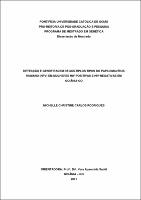| Compartilhamento |


|
Use este identificador para citar ou linkar para este item:
http://tede2.pucgoias.edu.br:8080/handle/tede/2341Registro completo de metadados
| Campo DC | Valor | Idioma |
|---|---|---|
| dc.creator | Rodrigues, Michelle Christine Carlos | - |
| dc.creator.Lattes | http://lattes.cnpq.br/6178721803202546 | por |
| dc.contributor.advisor1 | Saddi, Vera Aparecida | - |
| dc.contributor.advisor1Lattes | http://lattes.cnpq.br/7496804650895441 | por |
| dc.date.accessioned | 2016-08-10T10:38:31Z | - |
| dc.date.available | 2013-06-18 | - |
| dc.date.issued | 2011-09-16 | - |
| dc.identifier.citation | RODRIGUES, Michelle Christine Carlos. DETECÇÃO E GENOTIPAGEM DE MÚLTIPLOS TIPOS DO PAPILOMAVÍRUS HUMANO (HPV) EM MULHERES HIV-POSITIVAS E HIV-NEGATIVAS EM GOIÂNIA-GO. 2011. 99 f. Dissertação (Mestrado em Ciências Humanas) - Pontifícia Universidade Católica de Goiás, GOIÂNIA, 2011. | por |
| dc.identifier.uri | http://localhost:8080/tede/handle/tede/2341 | - |
| dc.description.resumo | Mulheres infectadas pelo HIV são mais susceptíveis à infecção por HPVs de alto risco oncogênico, que apresentam um potencial para a progressão para o câncer cervical. Conhecer a prevalência dos tipos específicos do papilomavirus humano nas mulheres HIV infectadas é necessário para planejar um rastreamento eficaz e estabelecer estratégias preventivas em tal população. Aqui, pudemos comparar a prevalência de infecções por múltiplos genótipos de HPV e de alterações citológicas em dois grupos de mulheres, HIV-positivas e HIV-negativas, da cidade de Goiânia- GO, Brasil. Esfregaços cervicais obtidos de 57 mulheres HIV-positivas e 57 mulheres HIV-negativas foram colhidos em meio conservante e enviadas para extração de DNA. A detecção de DNA e genotipagem do HPV foram realizadas usando o Kit Linear Array HPV Genotyping Test, de acordo com o manual fornecido pelo fabricante. Ambos os grupos foram semelhantes no que diz respeito à demografia, aos aspectos sociais e comportamentais. A detecção do DNA de HPV foi significativamente mais prevalente em mulheres HIV positivas, em comparação com as mulheres HIV-negativas (56,7% vs. 28,3%, p = 0,003). Coinfecção por vários genótipos de HPV também foi mais prevalente no grupo de HIV-positivas (88,2% vs. 58,8%, p = 0,028). O HPV16 foi o genótipo mais prevalente em ambos. Anormalidades citológicas foram observadas em 5,3% das mulheres HIV-negativas e 29,8% das mulheres HIV-positivas. A presença de HPV foi significativamente associada com anormalidades citológicas somente nas mulheres HIV-negativas Nossos resultados demonstraram uma maior prevalência de infecção por HPV no grupo de mulheres HIV-positivas, com um elevado número de casos de infecção por vários genótipos. Enfatizamos aqui a necessidade de monitoramento frequente de mulheres infectadas pelo HIV, de modo a permitir o diagnóstico precoce e tratamento eficaz para neoplasia intra-epitelial cervical (NIC) neste grupo de alto risco. | por |
| dc.description.abstract | HIV-infected women are more likely to be infected with high-risk HPV genotypes that have the potential for progressing to cervical cancer. To Know the prevalence of type-specific human papillomavirus (HPV) infections in HIV-infected women is necessary in order to plan effective screening and preventive strategies in such population. Here, we compare the prevalence of infections with multiple HPV types and cytological abnormalities in two groups of women, HIV-positive and HIVnegative, in the city of Goiânia-GO, Brazil. Cervical smears obtained from 57 HIVpositive and 57 HIV-negative women were collected in a preservative medium and submitted to DNA extraction. HPV-DNA detection and genotyping were performed by using the Linear Array HPV Genotyping Test according to the manual provided by the manufacturer. Both groups were similar in regard to social aspects, demographics and behavioral characteristics. HPV DNA was significantly more prevalent in HIV-positive women, compared to HIV-negative women (56.7% vs. 28.3%, p = 0.003). Coinfections with HPV multiple genotypes was also more prevalent in the HIV-positive group (88.2% vs. 58.8%, p = 0.028). HPV16 was the most prevalent in both groups. Cytological abnormalities were observed in 5.3% of HIV-negative women and in 29.8% HIV-positive women. The presence of HPV was significantly associated with cytological abnormalities only in HIV-negative women. Our results demonstrated a greater prevalence of HPV infection in the HIV-positive group of women, with a greater prevalence of infection with multiple genotypes. We here emphasize the need of frequent monitoring of HIV-infected women, in order to allow early detection and efficient treatment for cervical intraepithelial neoplasia (CIN) in this high-risk group. | eng |
| dc.description.provenance | Made available in DSpace on 2016-08-10T10:38:31Z (GMT). No. of bitstreams: 1 MICHELLE CHRISTINE CARLOS RODRIGUES.pdf: 555304 bytes, checksum: 013acceaa7a318df34a1985d5405b098 (MD5) Previous issue date: 2011-09-16 | eng |
| dc.format | application/pdf | por |
| dc.thumbnail.url | http://localhost:8080/tede/retrieve/7539/MICHELLE%20CHRISTINE%20CARLOS%20RODRIGUES.pdf.jpg | * |
| dc.language | por | por |
| dc.publisher | Pontifícia Universidade Católica de Goiás | por |
| dc.publisher.department | Ciências Humanas | por |
| dc.publisher.country | BR | por |
| dc.publisher.initials | PUC Goiás | por |
| dc.publisher.program | Genética | por |
| dc.rights | Acesso Aberto | por |
| dc.subject | Papilomavírus Humano | por |
| dc.subject | Vírus da Imunudeficiência Humana | por |
| dc.subject | câncer cervical | por |
| dc.subject | múltiplos genótipos do HPV | por |
| dc.subject | hibridização | por |
| dc.subject | Human Papillomavirus | eng |
| dc.subject | Human Immunedeficiency Virus | eng |
| dc.subject | cervical cancer | eng |
| dc.subject | multiple HPV genotypes | eng |
| dc.subject | hybridization | eng |
| dc.subject.cnpq | CNPQ::CIENCIAS BIOLOGICAS::GENETICA | por |
| dc.title | DETECÇÃO E GENOTIPAGEM DE MÚLTIPLOS TIPOS DO PAPILOMAVÍRUS HUMANO (HPV) EM MULHERES HIV-POSITIVAS E HIV-NEGATIVAS EM GOIÂNIA-GO | por |
| dc.type | Dissertação | por |
| Aparece nas coleções: | Mestrado em Genética | |
Arquivos associados a este item:
| Arquivo | Descrição | Tamanho | Formato | |
|---|---|---|---|---|
| MICHELLE CHRISTINE CARLOS RODRIGUES.pdf | 542,29 kB | Adobe PDF |  Baixar/Abrir Pré-Visualizar |
Os itens no repositório estão protegidos por copyright, com todos os direitos reservados, salvo quando é indicado o contrário.




